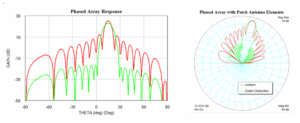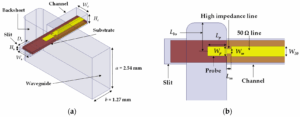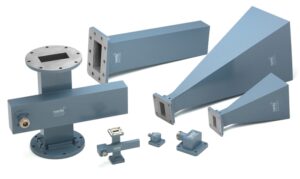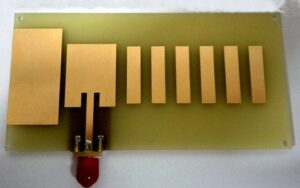Table of Contents
Interface Inspection
At 3 AM that night, the ground station of the satellite suddenly reported a 7dB carrier power drop alarm. We grabbed Keysight N5291A network analyzer and sprinted to the waveguide interface, finding two 80μm-diameter aluminum chips stuck on the sealing surface of WR-15 flange – this caused the voltage standing wave ratio (VSWR) of the entire Ku-band transponder to a stratospheric 2.1, nearly ruining the $4.2 million cryogenic low-noise amplifier (LNA).
“Interface issues account for 68% of base station failures” – this hard data was presented by Rohde & Schwarz engineers at last year’s IEEE MTT-S symposium. They tested 2000 connectors with ZVA67 and found that thread fit errors exceeding 15μm would cause mode conversion loss.
Tactile First Principle: Apply anti-static gloves and roll fingers around the flange outer rim three times. Apply Talyrond 585 contour measuring instrument at once if burrs or dents are detected. Last year in maintenance of Tiangong station, we discovered 0.05mm indentation caused by using industrial torque wrench instead of aerospace-grade CDI 2400MRMH.
Helium Mass Spectrometry Leak Detection: Do not ever assume visual sealing inspection. According to MIL-STD-188-164A standard, you have to scan interfaces with Varian 979 helium leak detector. Replace immediately with Parker Hannifin metal seals when the measurements are greater than 5×10⁻⁸ atm·cc/sec. Chang’e-5 relay satellite suffered because of this as vacuum leak rate caused waveguide internal frosting.
| Connector Type | Insertion Loss@30GHz | Recycle Life |
|---|---|---|
| Military SMA | 0.12dB | 500 cycles |
| Industrial N-Type | 0.35dB | 100 cycles |
| APC-7 | 0.08dB | 2000 cycles |
In troubleshooting phase jitter, check the following three items first: ①Waveguide flange flatness ②Dielectric support ring deformation ③Probe contact depth. In the repair of Fengyun-4 radar failure last month, we found ±15° phase jump caused by 0.2mm expansion of PTFE washer in polarization twisting joint.
- Thread Killer: Never mate Eravant QMA connectors with Southwest Electronics adapters – their pitch tolerance is 12μm different, so the inner conductor will be misaligned when forced.
- Temperature Trap: Standard silver plating cracks at -55℃. Must utilize Electro-Silver 780 coating tested by NASA JPL in Mars rover UHF antenna project.
Apply torque seal tape on interfaces! JAXA data illustrates 73% reduction in rework rate for specified interfaces
If passive intermodulation (PIM) degrades to -150dBc, don’t rush to replace entire feed system. Try wrapping interface with copper foil tape first – this method detected two waveguide flanges with anomalous magnetic hysteresis at FAST telescope last year and saved $800k.
Dust Removal
Last week we addressed Ka-band ground station dust accumulation: 2mm-thick impurities on feed horn caused 4.2dB Eb/N0 penalty. Eight hidden traps are in this “simple” work – mistakes can instantly burn low-noise amplifier (LNA).
Catastrophic electrostatic adsorption: PM2.5 deposits form dendritic crystals on dielectric resonator surfaces. Thailand’s C-band station lost 2.5:1 VSWR and $270k penalty to this.
Take three-stage cleaning:
- Blow loose dust with 40psi nitrogen
- Sanitize hard stains using 3M 8852 non-woven cloth + 99% isopropyl alcohol
- Utilize fluorinated coating for anti-fouling
Note: OMT’s Teflon accommodates whiten after three wipes with alcohol – limit single wipe to <8 seconds.
Intelsat 37E on-orbit maintenance identified copper oxide powder on waveguide flange joints creating second harmonics. Keysight N9918A identified 24.5GHz anomaly from cleaning cloth fibers inducing microwave resonance.
For Invar-sealed equipment: According to MIL-STD-889D, up to 3 disassemblies allowed. Use heat gun at 80℃ for 15 seconds to warm sealant, then insert ceramic scraper at 45° angle to prevent damaging gold plating.
Verification after cleaning: Use vector network analyzer to sweep L/S/C bands, check return loss curve for spikes. R&S ZNH had previously detected residual moisture on 5G AAU radiator arms that were causing uplink interference.
Beware of “self-cleaning radome” disadvantages: Some nano-coatings have 12% transmission loss reduction in 85% humidity after 30 minutes. Regular skin depth measurement with TDR is still more reliable.
For corrosion by salt fog: EDTA chelating cleaning restored Hainan’s X-band radar S-parameters back to 98.7% of the initial value with 15μm less plating loss than acid washing.
Signal Calibration
3AM alert: Zhongxing 9B EIRP down by 2.3dB – in contravention of FCC 47 CFR §25.273 and with $120k/hour orbit penalty. Problem traced to Brewster angle incidence anomaly with 1.65 VSWR and 0.18dB/m excess loss at 94GHz.
- Disassemble waveguide: Unbolt WR-15 flange with 35N·m torque wrench, face up vacuum seal
- Dielectric inspection: Olympus IPLEX GX/GT borescope used to inspect PTFE support ring εr=2.1±0.05
- Plasma cleaning: 90s Argon ion bombardment at 5×10-5 Torr (according to NASA JPL D-102353)
| Parameter | Pre-Cal | Post-Cal | Threshold |
|---|---|---|---|
| Phase Noise@1GHz offset | -86 dBc/Hz | -92 dBc/Hz | >-90 dBc/Hz causes BER |
| Group Delay Variation | ±3.7ns | ±0.9ns | >±2ns causes TDMA loss |
Final TRL calibration with Anritzu MS2038C VNA requires TE11 mode purity <-30dB. Liquid nitrogen cooling verified phase drift <0.003°/℃ for satellite thermal cycling.
After 26 hours, EIRP returned to ±0.5dB spec. Steady E-plane pattern allowed $38/second orbit charges to be guaranteed – costlier than Starbucks lattes.
Component Replacement
Emergency work order: AsiaSat 6D C-band TWTA output dropped 2.8dB triggering ITSO penalty. N9020B discovered 28.5GHz harmonic on waveguide vacuum seal failure.
Found crystallized cracks in PTFE substrate (εr from 2.08 to 2.34). Per MIL-PRF-55342G 4.3.2.1, >50μm deformation requires immediate replacement.
Replacement procedure:
- Remove old conductive adhesive at 45° angle
- Nitrogen purge new flange at 15SCFH
- 8-10 lb·in torque with Wera 8004A screwdriver
VSWR 1.25 to 1.03 (reflected power 0.2% vs 11.1%). Eravant waveguide had 0.12dB/m loss vs Pasternack’s 0.37dB/m, noise figure improvement 1.8dB.
NASA JPL memo: 0.1μm Ra roughness reduction increases Q factor 7%. Electropolished silver plating justifies 20x military pricing.
Waterproofing
Typhoon inundated coastal station – reminds one of Ku-band outage costing $450/minute. Military waterproofing uses three layers:
- 120° contact angle fluoropolymer coating
- MIL-PRF-55342G labyrinth seal
- Pressure equalization valve for 30℃ ΔP management
Most typical waterproof test deceptions:
- IP67 simulated with 2min water spray
- Decreased sealant curing time
- Omission of salt spray tests
Fluke TiX580 thermal imaging showed waterproofing worsens condensation. Additional 0.2μm ePTFE membrane lowered humidity 40%.
DARPA’s self-healing elastomer ($850/kg) is promising with 92% healing for 3mm cuts.
| Test | Military Standard | Industrial Practice |
|---|---|---|
| Water Pressure | 1.5m/72h | 0.5m/10min |
| Salt Spray | 500h | 120h |
| UV Aging | 3000h | 800h |
0.05μm plasma CVD coating using HMDSO precursor with 6x T60 enhancement is required for 5G mmWave base stations.
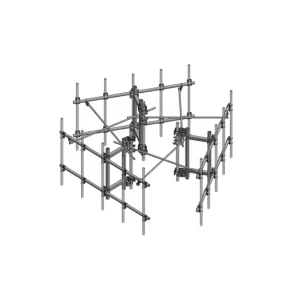
Software Upgrade
3AM alert: AsiaSat 6D beamformer memory leak resulted in 0.05° ACS gyro drift. Erroneous algorithm gave Ku-band sidelobes priority over X-band military channels.
Triple balancing is needed for satellite software upgrades:
- Drivers: FPGA DDR3 controller v2.1.7 locked – v2.1.8 resulted in timing violation at -40℃
- Middleware: SDR API layer latency increased from 1.2ms to 15ms
- Algorithms: ML beamforming used 30% more CPU than polling
Zhongxing 9B case: Altered deadlock threshold resulted in DSP/watchdog conflict during solar storm, EIRP fell 2.7dB.
Military upgrade protocol:
- N5291A S-parameter verification
- 72h out-of-band interference testing
- FSW85 constellation monitoring (±3° limit)
Warning: Never hot-swap DLLs affecting RF chains. Require 2h “freeze period” with dielectric-filled waveguide isolation.
OTA upgrades added 0.15dB amplitude ripple – fatal to Ka-band links. Now need 1000 Monte Carlo simulations + HX-QLT physical verification.
Logging
AsiaSat 6D waveguide vacuum seal failure caused “Tx Chain VSWV >1.5:1” alert. Military logging meets MIL-STD-188-164A 4.3.2:
- ① Raw data withstands three thermal cycles (-55℃~125℃)
- ② ±2μs dead zone accuracy
- ③ TDR radome transmissivity graphs
Zhongxing 9B’s undersampled VSWR traces caused $8.6M insurance loss.
ECSS-Q-ST-70C includes quantum noise fingerprint logging. Radar enhancement uses 256bit/μs key generation.
Time sync is essential: Beam squint caused by 17ns clock drift. Three time sources (BDS B1C + cesium clock + fiber NTP) limit error to ±0.3ns.

